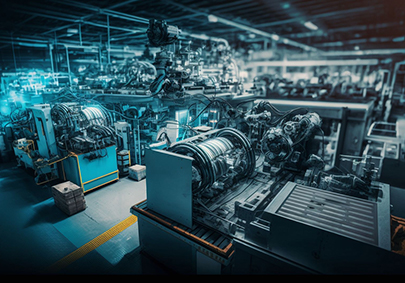Unveiling the World of Digital Engineering
Unveiling the World of Digital Engineering In the ever-evolving sphere of technology and innovation, the concept of “digital engineering” has emerged as a revolutionary force that is reshaping the landscape of designing, constructing, and maintaining intricate systems. Digital engineering isn’t merely a buzzword; it represents a comprehensive strategy that leverages state-of-the-art digital tools, data analytics, and collaborative methodologies to fundamentally transform the entire lifecycle of product development. In this article, we will delve into the notion of digital engineering, dissect its fundamental components, and elucidate why it holds a progressively significant role in the dynamic world of today. The Bedrock of Digital Engineering Digital engineering stands as a holistic approach to engineering, harnessing digital techniques, processes, and technologies to construct the digital counterpart of a product or system, mirroring its complete lifecycle. This approach spans across a multitude of disciplines, encompassing mechanical, electrical, software, and systems engineering, all in pursuit of crafting an integrated digital replica of a product or system. The crux of this concept revolves around departing from traditional paper-based design practices and adopting a digital-first philosophy. This entails creating and continuously updating a digital twin, which replicates the physical product or system, allowing engineers and stakeholders to collaborate, simulate, analyze, and optimize at every juncture of the development process. The Vital Components of Digital Engineering To fully grasp the essence of digital engineering, it’s imperative to delve into its pivotal components and their harmonious integration: Digital Twin: At the core of digital engineering resides the concept of a “digital twin.” This digital twin stands as the virtual counterpart of a physical product or system. It is a dynamic model that evolves over time, capturing design modifications, performance data, and maintenance particulars. This digital twin serves as the sole source of truth for all individuals involved in the project. Collaborative Environment: Digital engineering thrives on collaboration. It leverages cloud-based platforms and tools that facilitate real-time cooperation among engineers, designers, and other stakeholders, regardless of their geographical locations. This collaborative environment nurtures innovation and expedites the design and development process. Simulation and Modeling: Digital engineering places paramount importance on simulation and modeling. Engineers employ advanced software tools to simulate the behavior of a product or system under diverse circumstances. This empowers them to identify and rectify issues early in the design phase, mitigating costly errors and rework in the later stages. Data Analytics: Data constitutes the cornerstone of digital engineering. It entails the collection, analysis, and interpretation of copious amounts of data generated throughout the product lifecycle. Data analytics can unearth invaluable insights, such as performance trends, maintenance requisites, and optimization prospects. Automation: Automation is another pivotal facet of digital engineering. It involves the utilization of artificial intelligence (AI) and machine learning (ML) to automate repetitive tasks, generate design recommendations, and augment decision-making. Automation not only economizes time but also elevates the quality of designs. The Digital Engineering Lifecycle Digital engineering encompasses the entire spectrum of product development, from ideation to retirement. Let’s dissect the key phases of this lifecycle: Ideation: The process initiates with ideation, where concepts are brainstormed, and initial ideas are conceived. Digital engineering permits rapid prototyping and concept validation through virtual models and simulations. Design and Development: In this phase, engineers craft intricate digital models of the product or system. These models encompass not only the physical geometry but also the underlying functionality and behavior. Collaboration amongst cross-functional teams is indispensable to ensure that all facets of the design are meticulously considered. Testing and Validation: Digital engineering empowers exhaustive testing and validation via simulations. Engineers can simulate real-world scenarios, such as extreme temperatures, stress factors, or fluid dynamics, to guarantee that the product or system meets performance prerequisites. Manufacturing and Production: The digital twin serves as an invaluable resource for the manufacturing and production stages. It furnishes manufacturers with precise directives, diminishing the likelihood of errors and ensuring that the final product aligns with the design specifications. Operations and Maintenance: Digital engineering extends its advantages to the operational phase. By perpetually updating the digital twin with real-world performance data, organizations can fine-tune maintenance schedules, predict equipment malfunctions, and elevate the overall reliability of the system. End of Life: Even when a product or system reaches the culmination of its lifecycle, digital engineering remains valuable. It aids in the decommissioning process, streamlining the recycling of components and mitigating environmental repercussions. The Merits of Digital Engineering Digital engineering presents an array of benefits that render it indispensable across various industries: Expedited Time-to-Market: By facilitating concurrent engineering and swift prototyping, digital engineering truncates product development cycles, enabling enterprises to introduce innovative products to the market with greater speed. Cost Reduction: Early detection and prevention of issues, along with optimized designs, result in cost savings. Reduced errors and rework further contribute to lower development expenditures. Heightened Quality: Simulation and modeling ascertain that products either meet or surpass performance criteria. This translates into superior-quality products that are less prone to failures in the field. Enhanced Collaboration: Digital engineering fosters collaboration among multifaceted teams, encompassing mechanical engineers, electrical engineers, software developers, and more. This interdisciplinary approach stimulates innovation and problem-solving. Informed Decision-Making: Data analytics and simulations supply engineers and decision-makers with priceless insights, empowering informed choices throughout the product lifecycle. Lifecycle Management: The capability to monitor and update the digital twin throughout its lifecycle ensures that products remain optimized and impeccably maintained. Applications Across Industries Digital engineering finds applications across a wide spectrum of industries, including: Aerospace and Defense: The design, simulation, and maintenance of aircraft and spacecraft benefit from digital engineering, guaranteeing safety and performance. Automotive: Digital engineering expedites the design of fuel-efficient, dependable vehicles while expediting the development of autonomous driving technology. Healthcare: Medical device design and simulation enhance patient outcomes and streamline regulatory approvals. Energy: The energy sector employs digital engineering to optimize the design and operation of power plants, renewable energy systems, and smart grids. Construction: Building design and construction draw upon digital engineering to enhance structural integrity and sustainability. Consumer Electronics: Digital engineering accelerates the
Unveiling the World of Digital Engineering Read More »






